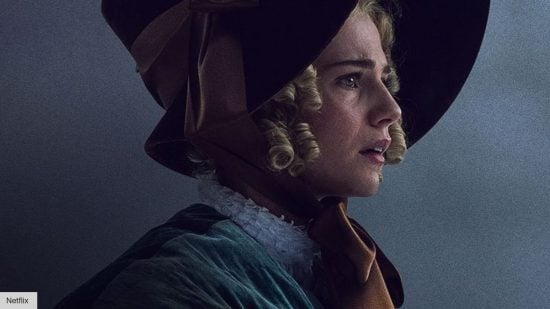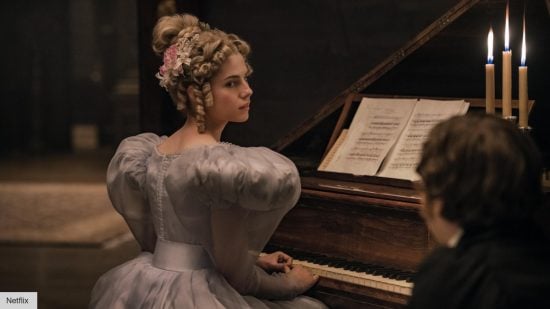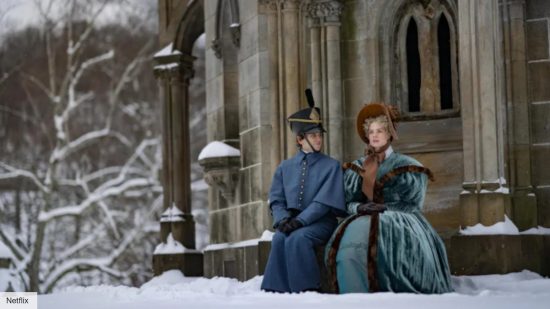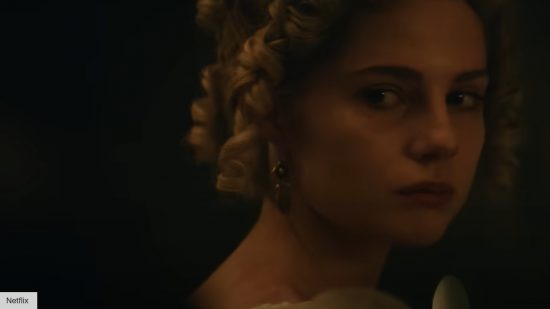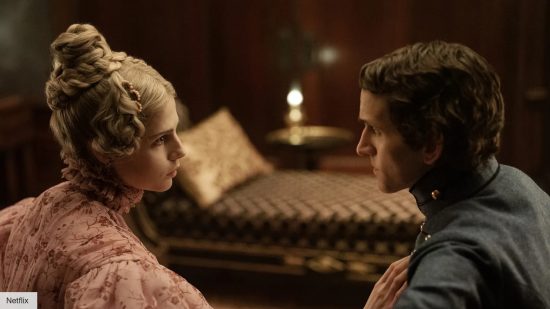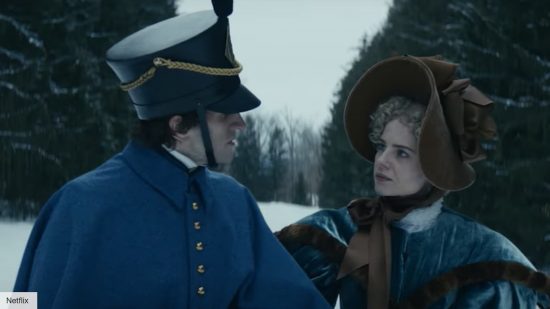Directed by Scott Cooper, The Pale Blue Eye is Netflix’s newest murder mystery, featuring iconic gothic writer Edgar Allan Poe. But as many fans of the spooky genre will know, while solving a crime is all well and good, you can’t have a Gothic storyline without a woman shrouded in intrigue.
Set in 1830, Lucy Boynton – best known for her role in Bohemian Rhapsody – plays the role of Lea Marquis, an ill woman who soon finds herself caught up in a case of murder at the United States Military Academy. Under the watchful eyes of detective Augustus Landor (Christian Bale) and the romantic intentions of Edgar Allan Poe (Harry Melling), Lea does what she can to survive.
To celebrate the upcoming release of The Pale Blue Eye on Netflix, Boynton sat down with The Digital Fix to discuss her new movie. In our interview, the star shares the detailed steps she took to get into character, her aspirations for a possible Mike Flanagan collaboration, and why she loves dark and gothic female stories so much.
So, The Pale Blue Eye’s mystery is very striking. But I wanted to know what first drew you to its script?
Lucy Boynton: I love this genre. I love any kind of dark material because you always know that it’s going to be a really interesting psychological investigation into almost every character. And also that your first read isn’t going to be the full picture; everything is going to reveal itself. I am always thrilled and drawn to dark material. And then, reading this, I don’t know! The premise felt kind of too good to be true.
Then the script exceeded those expectations. I loved that it was anchored in Edgar Allan Poe, a real person. The tone of the script, the environment, and then the fictionalised version we saw, that was able to leap off of Poe’s work and who we know him to be to reveal a very different side of the character.
I think the constant twists and turns that the film takes in a – not in a thriller way – very kind of emotive way, really drew me in. You never get to settle in The Pale Blue Eye. You’re constantly uneased by some new reveal. And I just love movies like that. I love stories like that. So yeah, it’s really exciting. The prospect of being part of it.

You mentioned how you’re drawn to dark stories, which brings me to my next question. I’ve read that you’re a huge fan of Shirley Jackson, the author of The Haunting of Hill House.
Oh, my God. Yeah, absolutely. Are you?
Yeah, I am! So, besides loving her work, you’ve acted now in a Edgar Allan Poe movie too. What is it about the genre of Gothic literature that speaks to you?
I think Shirley Jackson was my entry point to loving gothic horror, and all of that, because I think it’s an opportunity to see much more interesting female characters. And it’s a really interesting kind of investigation into the psychoanalysis of people. I don’t know. My friend always says that you can speak to any issue if you dress it up in genre.
So I think horror, you know, with Get Out and Nope and horror movies like that, they’re such good examples of how you can speak to something politically prevalent. In horror, it’s used as Trojan horses, and messenger bots in a very emotive way. And so I’m really intrigued by the horror genre as like a tool and a vehicle to do that.
But also, I think, on a very basic level, it’s a really fun experience as an actor, because it’s a really technical analytical process of working out how to portray something honestly, while also very specifically manipulating the audience’s experience of it. And being way more conscious of the audience’s experience than you would in any other genre. So it’s a really fun kind of puzzle to put together.
On the topic of female characters – your character in The Pale Blue Eye is a young woman in the 1800s. Period pieces make you realise how dirty society actually did women. As an actor, is it hard to get into the mindset of the oppressive time period?
I think I’m grateful for the opportunity to hold that mirror up again and again. And I think I’m always trying to look for roles where it does that in like a proactive way. I’m really lucky that I’ve come into the industry at a time when women were already kind of putting their foot down and saying they don’t just want to play the supporting role, asking the questions that continue the man’s story. They’re not just going to play the wife and the girlfriend anymore.
And so I am very much aware that I very much benefited from the bravery of those women. And I kind of, therefore, only wanted to do the same. I think the way that period pieces are written now is very different. And you can’t get away with writing anything less than a three-dimensional character. But again, I think this is a genre where that’s taken even further, with it being even more fascinating.
It’s an opportunity to kind of turn that on the head and reveal that women have always been so intelligent and fascinating, and have been so aware of the environment and the kind of puppet show that they’ve been placed in. That they’ve always been playing the game in some way as well.
And so, to then shine a light on that with films, going back into period pieces and The Pale Blue Eye, which actually get to investigate what women were thinking and experiencing -not from a male gaze, but from the inside workings – I think it’s really thrilling.
I really loved your character Lea. But one of the things that really stuck with me about her was how she was so ill throughout the movie. And there’s, even one scene when you actually have a seizure. How did you prepare for that physical moment?
It was working out the play-by-play process of what it is. What it physically and medically is to have an epileptic seizure. My director Scott put me in contact with a medical expert who kind of explained the biological or physical process of it. And then working out from a character point of view how you try and fight against that when you’re really trying for it not to happen in that moment, but it’s a physical inevitability.
And so, it was really interesting. It was difficult trying to portray it honestly and accurately, and not in a kind of glossy, cinematic way. So that it’s true. While also, yeah, being someone who’s trying to fight against it, and she’s trying to conceal it, and then she has to succumb to it. So it’s kind of like, ‘do loads and loads of research, and then just throw it all the way in order to be able just to try it.’
And that’s a privilege of, I think, working with a director that you really trust, where I can just kind of really give it a go. And I know that I’m in great hands where he’ll be able to kind of tweak it technically with me, and we’ll just keep trying it until it’s correct.
Lea is the embodiment of Gothic horror. I mean, you can’t have Gothic horror without that ghostly woman who’s in between life and death. And it just made sense that your character gravitates towards Edgar Allan Poe, as well. You and Harry Melling, have great chemistry; what was it like working with him?
It was great. I mean, Harry’s such a beautiful soul. He’s so sensitive, kind and nurturing. So it was just really pleasant to be around him and such a joy to find these characters. And I think their relationship is so beautiful. They both have such a vivid experiences of otherness.
And so I think when they meet, they really see each other and understand each other, and so he doesn’t treat her with the kind of delicacy that other people have, because of her frailty. And she doesn’t see him at all as an outsider. They have very similar avenues of interest. It was really fun to just play with that. And, he’s such a great guy. It was just a genuine pleasure to spend time with him.
Going back to Shirley Jackson for a moment. We’ve seen her work become really popular. We had The Haunting of Hill House on Netflix. And now Mike Flanagan, who helmed that horror series, is also doing an Edgar Allen Poe series – The Fall of the House of Usher.
Oh my god, of course!
I think it is about time you hit up Mike and start working on a collaboration. [laughs]
I know, right?! I’m such a huge fan of Mike Flanagan, and I think he’s a genius. So hell, yeah. Sign me up for whatever is next.
You mentioned Scott Cooper, your director. He has a reputation for being a really hands-on type of director with his actors. What was your experience with him leading you on set?
I think his background in acting helps his ability to communicate so much, or informs his ability to communicate with actors. Because he does it in such a sensitive way that is so empathetic and sensitive to your headspace of the scene.
So whenever he comes over and gives direction, it’s incredibly intimate. And it allows you to stay in the kind of frequency of that scene, the tone of that scene, and just build upon that. And that was such an amazing experience, especially in the really emotional scenes and the kind of emotional climaxes of the movie. To have that kind of connection with someone was a real gift. So that we could just keep building rather than stopping, starting, interrupting and starting again.
He cares so much, personally, about the characters. Like he has such as sensitive empathy for each character that I think when you’re operating from that as an anchor and as a foundation, you’re kind of set up to succeed because you’re starting from such an emotionally intuitive place. And such a place of honesty that he keeps you honest throughout the process. Yeah, it was such a great experience. On a technical level as well, I’m such a huge fan of his work.
We’ve talked a lot about the genre of gothic horrors and thrillers. There is always that twist and unexpected turn in movies like The Pale Blue Eye. When you read the script, did you expect the fate of your character? Without giving any spoilers, obviously!
I don’t think so! I don’t think I could have seen it coming. I was hopeful. But, that’s the brilliance of that book and the writing and the way that it’s handled. I didn’t, and I hope no one else does when they watch the movie. [laughs] I’m so, like, desperate not to say anything in case of spoiling.
The Pale Blue Eye hits Netflix on January 6. For more spooky content, here are our guides to the best ghost movies and the best monster movies of all time.
